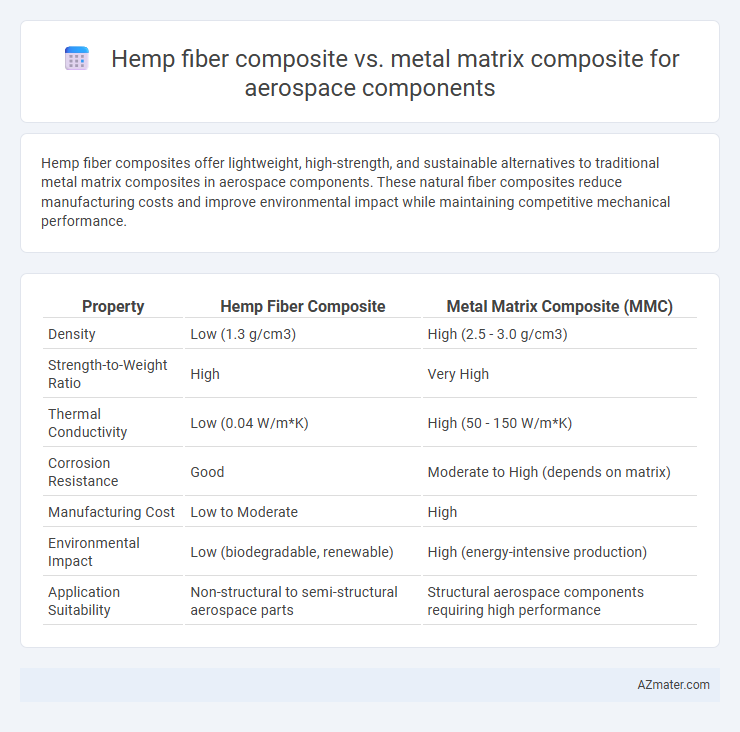Hemp fiber composites offer lightweight, high-strength, and sustainable alternatives to traditional metal matrix composites in aerospace components. These natural fiber composites reduce manufacturing costs and improve environmental impact while maintaining competitive mechanical performance.
Table of Comparison
| Property | Hemp Fiber Composite | Metal Matrix Composite (MMC) |
|---|---|---|
| Density | Low (1.3 g/cm3) | High (2.5 - 3.0 g/cm3) |
| Strength-to-Weight Ratio | High | Very High |
| Thermal Conductivity | Low (0.04 W/m*K) | High (50 - 150 W/m*K) |
| Corrosion Resistance | Good | Moderate to High (depends on matrix) |
| Manufacturing Cost | Low to Moderate | High |
| Environmental Impact | Low (biodegradable, renewable) | High (energy-intensive production) |
| Application Suitability | Non-structural to semi-structural aerospace parts | Structural aerospace components requiring high performance |
Introduction to Aerospace Composite Materials
Hemp fiber composites offer lightweight, biodegradable alternatives with high tensile strength and low environmental impact, making them attractive for sustainable aerospace components. Metal matrix composites (MMCs) provide superior thermal stability, high stiffness, and excellent wear resistance, essential for high-temperature aerospace applications. The choice between hemp fiber composites and MMCs depends on balancing sustainability, mechanical performance, and operational environment in aerospace design.
Overview of Hemp Fiber Composites
Hemp fiber composites offer a lightweight, sustainable alternative to traditional aerospace materials, providing high specific strength and excellent vibration damping properties. These natural fiber composites exhibit superior biodegradability and lower environmental impact compared to metal matrix composites, while maintaining adequate mechanical performance for non-structural aerospace components. Advances in matrix resin formulations enhance hemp fiber composites' durability and resistance to moisture, making them increasingly viable for aerospace applications.
Fundamentals of Metal Matrix Composites
Metal Matrix Composites (MMCs) combine metallic matrices like aluminum or titanium with reinforcement fibers such as silicon carbide, offering superior strength-to-weight ratios and excellent thermal stability crucial for aerospace components. Unlike hemp fiber composites, which rely on natural fibers embedded in polymer matrices, MMCs provide enhanced stiffness, wear resistance, and high-temperature performance essential for structural aerospace applications. The fundamental advantage of MMCs lies in their ability to maintain mechanical integrity under extreme operational conditions, making them ideal for high-load and high-temperature aerospace environments.
Mechanical Properties: Strength and Stiffness Comparison
Hemp fiber composites exhibit moderate tensile strength and stiffness, typically ranging from 300 to 600 MPa in strength and 20 to 40 GPa in stiffness, offering lightweight alternatives with good impact resistance for aerospace components. Metal matrix composites (MMCs), composed of aluminum or titanium alloys reinforced with ceramic fibers, provide superior mechanical properties with tensile strengths exceeding 700 MPa and stiffness values above 100 GPa, ensuring high load-bearing capacity and thermal stability. The strength-to-weight ratio favors hemp fiber composites for applications prioritizing weight reduction, while MMCs dominate in environments demanding extreme mechanical durability and stiffness.
Weight and Density: Impacts on Aerospace Design
Hemp fiber composites exhibit significantly lower density, approximately 1.3-1.5 g/cm3, compared to metal matrix composites, which range from 2.5 to over 4.5 g/cm3, resulting in substantial weight savings critical for aerospace applications. The reduced weight of hemp fiber composites enhances fuel efficiency and payload capacity, directly influencing aircraft performance and operational costs. Metal matrix composites offer superior mechanical strength and thermal resistance but often at the expense of increased weight, necessitating trade-offs in aerospace design priorities.
Thermal Stability and Heat Resistance Performance
Hemp fiber composites exhibit moderate thermal stability with degradation temperatures around 200-250degC, making them suitable for low to medium temperature aerospace applications but limiting their use in high-heat environments. Metal matrix composites, typically aluminum or titanium reinforced with ceramics, demonstrate superior heat resistance and thermal stability, tolerating temperatures above 400degC while maintaining structural integrity under thermal cycling. This inherent thermal resilience makes metal matrix composites preferred for aerospace components requiring high heat resistance and prolonged exposure to elevated temperatures.
Corrosion Resistance and Durability Analysis
Hemp fiber composites demonstrate superior corrosion resistance compared to metal matrix composites (MMCs) due to their inherent non-metallic nature, reducing susceptibility to oxidation and chemical degradation in aerospace environments. Durability analysis reveals that hemp fiber composites offer enhanced fatigue resistance and impact absorption, contributing to longer service life under cyclic loading conditions typical in aerospace applications. Metal matrix composites exhibit higher stiffness and thermal stability but often require protective coatings to mitigate corrosion, impacting maintenance demands and overall lifecycle costs.
Manufacturing Processes and Cost Efficiency
Hemp fiber composites offer low-cost manufacturing through processes like compression molding and resin transfer molding, providing lightweight alternatives with reduced energy consumption compared to metal matrix composites, which require expensive methods such as powder metallurgy or casting combined with high-temperature sintering. The natural fibers in hemp composites reduce processing time and tool wear, significantly lowering production expenses, whereas metal matrix composites demand precise control and extensive machining, increasing overall costs. Cost efficiency in aerospace components is enhanced by hemp fiber composites due to their simpler manufacturing routes and sustainable material sourcing, despite metal matrix composites delivering superior mechanical properties for high-stress environments.
Environmental Sustainability and Lifecycle Assessment
Hemp fiber composites offer significant environmental sustainability advantages over metal matrix composites in aerospace applications due to their renewable nature, lower energy consumption during production, and superior biodegradability. Lifecycle assessment reveals hemp composites generate substantially lower carbon emissions and reduce end-of-life disposal impacts compared to energy-intensive metal matrix composites, which involve mining and complex recycling processes. The integration of hemp fibers in aerospace components supports circular economy principles by promoting resource efficiency and minimizing ecological footprints throughout the product lifecycle.
Future Prospects: Innovations in Aerospace Component Materials
Hemp fiber composites offer significant advantages in aerospace applications due to their lightweight nature, biodegradability, and cost-effectiveness, driving innovation in sustainable material development. Metal matrix composites (MMCs) provide superior strength, thermal stability, and wear resistance, making them critical for high-performance aerospace components subjected to extreme conditions. Future prospects include hybrid composites combining hemp fibers with metal matrices to optimize strength-to-weight ratios and enhance environmental sustainability in advanced aerospace manufacturing.

Infographic: Hemp fiber composite vs Metal matrix composite for Aerospace component
 azmater.com
azmater.com